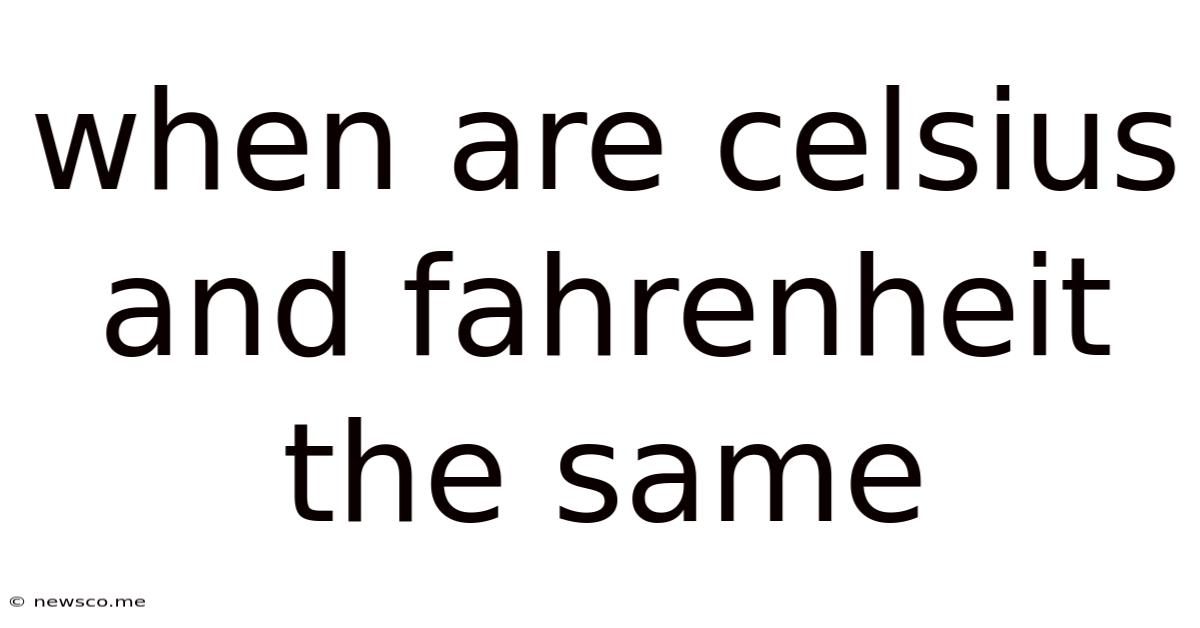When Are Celsius And Fahrenheit The Same
News Co
Mar 26, 2025 · 4 min read

Table of Contents
When Are Celsius and Fahrenheit the Same? Unraveling the Mathematical Mystery
Have you ever wondered if there's a point where the Celsius and Fahrenheit scales, those ubiquitous temperature measurement systems, align? It's a fascinating question that delves into the heart of unit conversion and reveals a surprising mathematical truth. This article will explore this intriguing intersection, providing a clear understanding of the underlying principles and demonstrating how to solve this unique equation.
Understanding Celsius and Fahrenheit
Before we delve into finding the point of equality, let's briefly review the two scales. Both Celsius (°C) and Fahrenheit (°F) are used to measure temperature, but they differ significantly in their reference points and scaling.
-
Celsius: This scale, also known as the centigrade scale, uses 0°C as the freezing point of water and 100°C as its boiling point at standard atmospheric pressure. The scale is divided into 100 equal intervals between these two points.
-
Fahrenheit: The Fahrenheit scale uses 32°F as the freezing point of water and 212°F as its boiling point at standard atmospheric pressure. The difference between these points represents 180 degrees.
The difference in their scaling and zero points leads to a non-linear relationship between the two scales. This means a simple multiplication or addition won't suffice to convert between them.
The Equation: Finding the Point of Convergence
To determine when Celsius and Fahrenheit readings are identical, we need to set up an equation that equates the two temperature scales. The standard formula for converting Celsius to Fahrenheit is:
°F = (9/5)°C + 32
Since we want to find the point where °F = °C, we can substitute 'x' for both °F and °C:
x = (9/5)x + 32
Now, we solve this algebraic equation for 'x':
-
Subtract (9/5)x from both sides:
x - (9/5)x = 32
-
Find a common denominator:
(5/5)x - (9/5)x = 32
-
Simplify:
-(4/5)x = 32
-
Multiply both sides by -5/4:
x = 32 * (-5/4)
-
Solve for x:
x = -40
Therefore, the solution reveals that -40°C is equal to -40°F. This is the only point where both scales agree.
Graphical Representation of the Intersection
Visualizing this solution can enhance understanding. A graph plotting Celsius against Fahrenheit would show two lines intersecting at the point (-40, -40). The lines represent the conversion formulas, demonstrating that only at this single point do the values perfectly overlap. The slope of the Fahrenheit line is steeper than the Celsius line, reflecting the different scale increments. The y-intercept of the Fahrenheit line is 32, highlighting the difference in the freezing point of water between the two scales.
Practical Implications and Further Exploration
The fact that -40°C equals -40°F might seem like a mere mathematical curiosity, but it does have practical applications. For example, in industries dealing with extremely low temperatures, knowing this single point of equivalence simplifies conversions and avoids potential errors. This is especially critical in scientific fields, engineering projects, and international collaborations where consistent temperature readings are paramount.
Furthermore, exploring the relationship between Celsius and Fahrenheit can extend into more complex scenarios. One could investigate temperature ranges where the difference between the two scales is minimal or maximal. Analyzing these differences could yield insights into the practical implications of using one scale over the other depending on the context.
One could also delve into the historical context of the development of each scale and their unique characteristics, including their strengths and weaknesses for particular applications. The evolution of temperature measurement is intertwined with advances in physics and the understanding of heat transfer. Examining the historical context could provide additional insights into the current widespread use of both scales.
Beyond the Basic Conversion: Exploring Other Temperature Scales
While Celsius and Fahrenheit are the most commonly used scales, others exist, such as Kelvin (K) and Rankine (°R). Kelvin, the base unit of thermodynamic temperature in the International System of Units (SI), starts at absolute zero, the theoretical point where all molecular motion ceases. Rankine, an absolute temperature scale based on Fahrenheit, also uses absolute zero as its starting point.
Understanding the relationships between these various scales can be beneficial in diverse scientific and engineering contexts. Each scale offers unique properties and is suitable for different applications. Exploring these variations can further enhance comprehension of temperature measurement and broaden the understanding of the mathematical relationships behind these scales.
Conclusion: A Single Point of Unity in Temperature Measurement
The question of when Celsius and Fahrenheit are the same leads us to a surprising and elegant solution: -40 degrees. This point of convergence, a solitary instance of equality between two vastly different temperature measurement systems, highlights the intriguing mathematical relationship between the two scales. This exploration provides a foundation for a deeper understanding of temperature conversion and opens doors to further exploration of other temperature scales and their applications. The seemingly simple question of finding the point of equality serves as a springboard for broader investigation into the physics and mathematics underlying temperature measurement, ultimately enriching our understanding of this fundamental physical quantity.
Latest Posts
Related Post
Thank you for visiting our website which covers about When Are Celsius And Fahrenheit The Same . We hope the information provided has been useful to you. Feel free to contact us if you have any questions or need further assistance. See you next time and don't miss to bookmark.